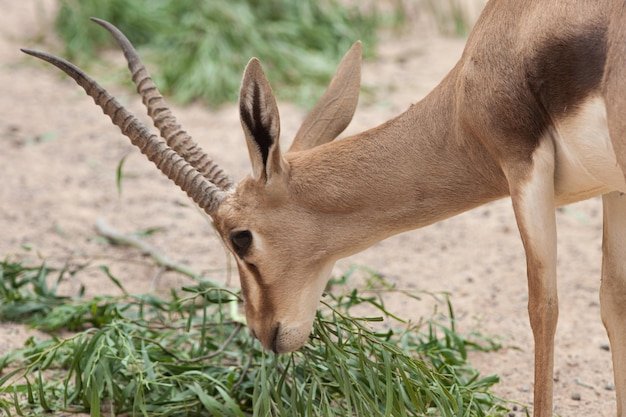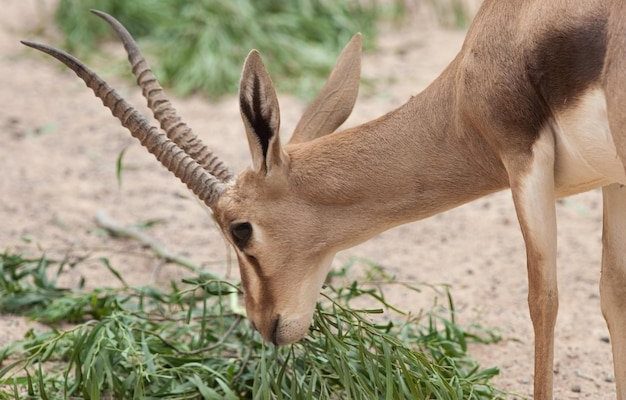
So, what does a gazelle eat, and how does it hunt? Well, here’s the twist: gazelles don’t actually hunt other animals. Instead, they are herbivores, grazing on plants and grasses. Understanding their diet and how they manage to stay one step ahead of predators is a bit like piecing together a fascinating puzzle of survival in nature. Grab a cup of coffee, and let’s dive into the world of gazelles!
The Gazelle’s Diet: What Do They Eat?
Gazelles are primarily herbivorous grazers, meaning their diet mainly consists of plant materials. They nibble on grass, leaves, and shrubs, which are widely available in their savanna habitats. Think of them as the constant munchers of the plains, always on the lookout for the freshest greens.
- Grasses: This is their staple food. Gazelles prefer tender, young grass that’s high in nutrients.
- Leaves: In drier seasons, when grass isn’t as plentiful, gazelles will munch on the leaves of shrubs and trees.
- Fruits and Flowers: They also enjoy fruits and flowers when available, adding a touch of variety to their diet.
You might be wondering why their diet is so focused on grasses. Well, they have adapted to eat quickly and efficiently. Gazelles can consume a lot of food in a short period, which is essential when they’re constantly on the move. After all, with predators like lions and cheetahs lurking around, a quick snack is always a smart choice.
Water Needs: Staying Hydrated in the Savanna
Surviving in the savanna isn’t just about having food—water is vital too. Gazelles are pretty remarkable when it comes to hydration. They’ve adapted to their environment in ways that might surprise you.
For one, they don’t need to drink water every day. Instead, they can get most of the moisture they need from the plants they consume. During the rainy season, when grass is green and juicy, they’ll drink less frequently. However, during the dry spells, they’ll seek out waterholes or rivers, knowing that hydration is crucial for their survival.
If you think about it, this ability is a survival tactic in itself. If they relied solely on finding water every day, they’d be easy prey, always visible near water sources. By being cautious and flexible with their water intake, they enhance their chances of living to graze another day.
Hunting Strategies: Gazelles Are Not Predators
Here’s the thing—while we often think of “hunting” in the animal kingdom as something that involves stalking prey, gazelles are herbivores and don’t hunt other animals. However, they do have some impressive strategies to avoid becoming lunch themselves!
Instead of hunting, gazelles rely on speed and agility. They can run up to 60 miles per hour! Think about how quickly they can dart away from danger. When a predator gets too close, a gazelle will often zigzag, making it harder for the predator to catch up.
Their keen eyesight plays a huge role in their survival, too. Gazelles have excellent peripheral vision, allowing them to spot threats from a distance. If they sense danger, it’s not just a mad dash that saves them. They’ll often freeze momentarily to assess the situation before making their escape. It’s a dance of instinct and survival that keeps them alive.
Group Dynamics: Why Gazelles Stay Together
You might have noticed that gazelles are rarely alone. They often travel in herds, and there’s a good reason for that! Staying in groups enhances their protection against predators. It’s like building a safety net.
When a gazelle is part of a herd, they can keep an eye out for one another. If one gazelle spots a predator, it can alert the rest of the group, giving everyone a chance to flee. Additionally, there’s strength in numbers; predators are less likely to target a large group compared to an isolated individual.
These social bonds also help with foraging. When gazelles graze together, they can cover more ground and find food more effectively. Plus, social interactions help establish hierarchies within the group, which can affect mating and territory.
The Role of Gazelles in the Ecosystem
It’s easy to see gazelles as just charming animals that grace the plains, but they play a crucial role in their ecosystem. By grazing on grasses, gazelles help maintain the balance of the savanna. Here’s how their diet impacts their environment:
1. Plant Growth: By eating grasses and shrubs, they encourage new growth. This helps keep the savanna healthy and thriving.
2. Food Source for Predators: Gazelles are a primary food source for several predators, from lions to hyenas. Without gazelles, many of these predators would struggle to survive.
3. Seed Dispersal: While munching on plants, gazelles inadvertently help in seed dispersal. As they move about, they carry seeds in their fur or digestive system, promoting diversity in plant life.
In this way, gazelles are more than just beautiful creatures; they’re integral to the health of their ecosystem. By understanding their role, we can appreciate the delicate balance of nature in the savanna.
The diet and hunting strategies of the gazelle offer an intriguing glimpse into how life adapts in the wild. Their role as herbivores, agile escape artists, and valued contributors to the ecosystem paints a full picture of their existence.
As the savanna faces challenges like habitat loss and climate change, it’s vital to protect these remarkable animals and their home. By appreciating the gazelle’s intricate lifestyle, we can better understand our responsibility in preserving the natural world. After all, maintaining the balance of nature benefits not just the gazelles, but all of us who share this planet.

